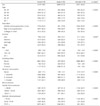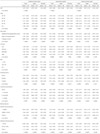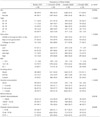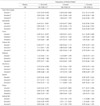Abstract
Limited studies are available concerning the effect of heavy metal exposure on cardiovascular diseases. As environmental pollution increases, food contamination, including heavy metal contamination of fish, also increases. However, researches based on the intake of heavy metals, cardiovascular disease, and fish intakes are inconclusive. We assessed an association of heavy metal exposure with cardiovascular disease and fish intake in a nationally representative group of general Korean adults. We used data from the combined 2008-2010 Korean National Health and Nutrition Examination Survey (KNHANES), and analyzed the data of 5,139 Koreans who participated in KNHANES. All participants were older than 20 years, and were diagnosed with stroke, ischemic heart disease, or hypertension. The mean blood cadmium, lead concentration, and mercury concentration of subjects were 1.07 ± 0.01 µg/L, 2.49 ± 0.02 µg/dL, and 5.19 ± 0.08 µg/L, respectively. We used the survey logistic regression model to account for the complex sample design of the cardiovascular disease risk in order to estimate the odds ratios (OR). After adjusting for age, education, income, alcohol, smoking, and BMI, the increase of serum cadmium in blood was associated with the increase in the prevalence of hypertension. Further, the increase in blood cadmium concentration was associated with the increase of both systolic blood pressure (SBP) and diastolic blood pressure (DBP). Although higher fish intakes were significantly associated with higher blood mercury concentration (p for trend < 0.0001), fish intakes did not affect either blood cadmium or lead concentration. Comparing the highest fish intake group with the lowest intake group, the OR of hypertension was 0.31 (95% CI: 0.19-0.59) in the crude model for total fish. However, these associations were no longer significant after the adjustment for potential confounding factors. In conclusion, cadmium in blood was associated with an increased risk of hypertension in the general Korean adult population. However, we found no evidence of a clear relationship between cardiovascular disease and frequency of fish consumption.
Figures and Tables
Table 3
Surveylogistic analysis for cardiovascular diseases associated with blood heavy metal by gender

References
1. Kim BH, Park MJ, Park SS, Park JW, Lee JK, Lim KH, Son KM, Yum K. Public health. 2005. Paju: Jigu Publishing Co.;131–133.
2. Chung JH, Kang PS, Kim CY, Lee KS, Hwang TY, Kim GT, Park JS, Park SY, Kim DS, Lim OT, Sakong J. Blood Pb, Urine Cd and health assessment of residents in the vicinity of abandoned mines in Gyeongsangbuk-do. Korean J Occup Environ Med. 2005. 17(3):225–237.

3. Kwon YT, Lee JA. Dietary risk assessment of heavy metals in Korean foods. Environ Res Inst. 2001. 24:33–44.
4. Korea Health Industry Development Institute. Dietary intake and risk assessment of contaminants in Korean foods. 2004. Cheongwon:
5. Alissa EM, Ferns GA. Heavy metal poisoning and cardiovascular disease. J Toxicol. 2011. 2011:870125.

6. Korea Food & Drug Administration. Cadmium. 2010. 12. Available from: http://www.foodnara.go.kr/portal/site/kfdaportal/infodangerseries/.
7. Korea Food & Drug Administration. Lead, Pb. 2010. 12. Available from: http://www.foodnara.go.kr/portal/site/kfdaportal/infodangerseries/.
8. Korea Food & Drug Administration. Methylmercury. 2010. 12. Available from: http://www.foodnara.go.kr/portal/site/kfdaportal/infodangerseries/.
9. National Institute of Food and Drug Safety Evaluation. Dietary intake and risk assessment of heavy metals. 2009. Cheongwon:
10. Korea Health Industry Development Institute. Dietary intake and risk assessment of contaminants in Korean foods. 2009. Cheongwon:
11. Ohn YH, Park JD, Choi BS, Hong YP, Chang IW. Blood cadmium and zinc and urinary N-acetyl-β-D-glucosaminidase activity in rural residents not exposed to cadmium. Chung-Ang J Med. 1995. 20(4):333–350.
12. Peters JL, Perlstein TS, Perry MJ, McNeely E, Weuve J. Cadmium exposure in association with history of stroke and heart failure. Environ Res. 2010. 110(2):199–206.

13. Mozaffarian D, Longstreth WT Jr, Lemaitre RN, Manolio TA, Kuller LH, Burke GL, Siscovick DS. Fish consumption and stroke risk in elderly individuals: the cardiovascular health study. Arch Intern Med. 2005. 165(2):200–206.

14. Yamagishi K, Iso H, Date C, Fukui M, Wakai K, Kikuchi S, Inaba Y, Tanabe N, Tamakoshi A. Japan Collaborative Cohort Study for Evaluation of Cancer Risk Study Group. Fish, omega-3 polyunsaturated fatty acids, and mortality from cardiovascular diseases in a nationwide community-based cohort of Japanese men and women the JACC (Japan Collaborative Cohort Study for Evaluation of Cancer Risk) Study. J Am Coll Cardiol. 2008. 52(12):988–996.

15. Mozaffarian D, Lemaitre RN, Kuller LH, Burke GL, Tracy RP, Siscovick DS. Cardiovascular Health Study. Cardiac benefits of fish consumption may depend on the type of fish meal consumed: the Cardiovascular Health Study. Circulation. 2003. 107(10):1372–1377.

16. Zhang J, Sasaki S, Amano K, Kesteloot H. Fish consumption and mortality from all causes, ischemic heart disease, and stroke: an ecological study. Prev Med. 1999. 28(5):520–529.

17. Abelsohn A, Vanderlinden LD, Scott F, Archbold JA, Brown TL. Healthy fish consumption and reduced mercury exposure: counseling women in their reproductive years. Can Fam Physician. 2011. 57(1):26–30.
18. Kris-Etherton PM, Harris WS, Appel LJ. American Heart Association, Nutrition Committee. Fish consumption, fish oil, omega-3 fatty acids, and cardiovascular disease. Circulation. 2002. 106(21):2747–2757.

19. Kim YA, Kim YN, Cho KD, Kim MY, Kim EJ, Baek OH, Lee BH. Blood heavy metal concentrations of Korean adults by seafood consumption frequency: using the fourth Korea National Health and Nutrition Examination Survey (KNHANES IV), 2008. Korean J Nutr. 2011. 44(6):518–526.

20. Lee SR, Lee MG. Contamination and risk analysis of heavy metals on Korean foods. J Food Hyg Saf. 2001. 16(4):324–332.
21. Vupputuri S, Longnecker MP, Daniels JL, Guo X, Sandler DP. Blood mercury level and blood pressure among US women: results from the National Health and Nutrition Examination Survey 1999-2000. Environ Res. 2005. 97(2):195–200.

22. Wennberg M, Bergdahl IA, Stegmayr B, Hallmans G, Lundh T, Skerfving S, Strömberg U, Vessby B, Jansson JH. Fish intake, mercury, long-chain n-3 polyunsaturated fatty acids and risk of stroke in northern Sweden. Br J Nutr. 2007. 98(5):1038–1045.

23. Kim NS, Lee BK. National estimates of blood lead, cadmium, and mercury levels in the Korean general adult population. Int Arch Occup Environ Health. 2011. 84(1):53–63.

24. Salonen JT, Seppänen K, Nyyssönen K, Korpela H, Kauhanen J, Kantola M, Tuomilehto J, Esterbauer H, Tatzber F, Salonen R. Intake of mercury from fish, lipid peroxidation, and the risk of myocardial infarction and coronary, cardiovascular, and any death in eastern Finnish men. Circulation. 1995. 91(3):645–655.

25. Kim DS, Lee EH, Yu SD, Cha JH, Ahn SC. Heavy metal as risk factor of cardiovascular disease : an analysis of blood lead and urinary mercury. J Prev Med Public Health. 2005. 38(4):401–407.
26. Agarwal S, Zaman T, Tuzcu EM, Kapadia SR. Heavy metals and cardiovascular disease: results from the National Health and Nutrition Examination Survey (NHANES) 1999-2006. Angiology. 2011. 62(5):422–429.

27. Eum KD, Lee MS, Paek D. Cadmium in blood and hypertension. Sci Total Environ. 2008. 407(1):147–153.

28. Ministry of Environment. White paper of environment. 2004. Gwacheon:
29. Weinhold B. Environmental cardiology: getting to the heart of the matter. Environ Health Perspect. 2004. 112(15):A880–A887.

30. Navas-Acien A, Guallar E, Silbergeld EK, Rothenberg SJ. Lead exposure and cardiovascular disease--a systematic review. Environ Health Perspect. 2007. 115(3):472–482.

31. Virtanen JK, Voutilainen S, Rissanen TH, Mursu J, Tuomainen TP, Korhonen MJ, Valkonen VP, Seppänen K, Laukkanen JA, Salonen JT. Mercury, fish oils, and risk of acute coronary events and cardiovascular disease, coronary heart disease, and all-cause mortality in men in eastern Finland. Arterioscler Thromb Vasc Biol. 2005. 25(1):228–233.

32. Statistics Korea. Deaths and causes of death in 2009. 2009. Daejeon:
33. Ministry of Health & Welfare. Korea health statistics, Korean National Health and Nutrition Examination Survey (KNHANES IV-3). 2009. Seoul:
34. Korea Centers for Disease Control and Prevention. The fourth Korea National Health and Nutrition Examination Survey. 2008. Cheongwon:
35. Ministry of Environment. The study of blood heavy metal concentration of Korean. 2005. Gwacheon:
36. Department of Health and Human Services, Centers for Disease Control and Prevention. Fourth national report on human exposure to environmental chemicals. 2009. Atlanta:
37. Son JY, Lee J, Paek D, Lee JT. Blood levels of lead, cadmium, and mercury in the Korean population: results from the Second Korean National Human Exposure and Bio-monitoring Examination. Environ Res. 2009. 109(6):738–744.

38. McKelvey W, Gwynn RC, Jeffery N, Kass D, Thorpe LE, Garg RK, Palmer CD, Parsons PJ. A biomonitoring study of lead, cadmium, and mercury in the blood of New York city adults. Environ Health Perspect. 2007. 115(10):1435–1441.

39. Tellez-Plaza M, Navas-Acien A, Crainiceanu CM, Guallar E. Cadmium exposure and hypertension in the 1999-2004 National Health and Nutrition Examination Survey (NHANES). Environ Health Perspect. 2008. 116(1):51–56.

40. Eun JK, Lee WS. Mercury contents of human scalp hair by the consumption pattern in fish. Korean J Sanit. 2000. 15(3):8–14.
41. Luoma PV, Näyhä S, Pyy L, Hassi J. Association of blood cadmium to the area of residence and hypertensive disease in Arctic Finland. Sci Total Environ. 1995. 160-161:571–575.

42. Lee B, Ha J. The Effects of smoking and drinking on blood lead and cadmium levels: data from the fourth Korea National Health and Nutrition Examination Survey. Korean J Occup Environ Med. 2011. 23(1):31–41.

43. Briganti EM, Branley P, Chadban SJ, Shaw JE, McNeil JJ, Welborn TA, Atkins RC. Australian Diabetes, Obesity and Lifestyle Study. Smoking is associated with renal impairment and proteinuria in the normal population: the AusDiab kidney study. Am J Kidney Dis. 2002. 40(4):704–712.

44. Pocock SJ, Shaper AG, Walker M, Wale CJ, Clayton B, Delves T, Lacey RF, Packham RF, Powell P. Effects of tap water lead, water hardness, alcohol, and cigarettes on blood lead concentrations. J Epidemiol Community Health. 1983. 37(1):1–7.

45. Iso H, Rexrode KM, Stampfer MJ, Manson JE, Colditz GA, Speizer FE, Hennekens CH, Willett WC. Intake of fish and omega-3 fatty acids and risk of stroke in women. JAMA. 2001. 285(3):304–312.

46. Xun P, Hou N, Daviglus M, Liu K, Morris JS, Shikany JM, Sidney S, Jacobs DR, He K. Fish oil, selenium and mercury in relation to incidence of hypertension: a 20-year follow-up study. J Intern Med. 2011. 270(2):175–186.

47. Kim HY, Kim JC, Kim SY, Lee JH, Jang YM, Lee MS, Park JS, Lee KH. Monitoring of heavy metals in fishes in Korea - As, Cd, Cu, Pb, Mn, Zn, total Hg. Korean J Food Sci Technol. 2007. 39(4):353–359.




 PDF
PDF ePub
ePub Citation
Citation Print
Print








 XML Download
XML Download